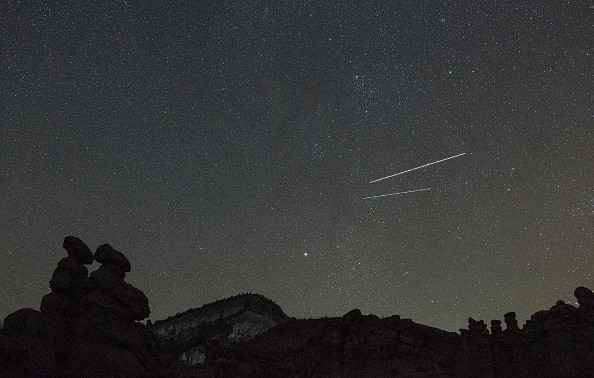Shooting stars will return to the night sky on April 21-22, after a three-month sabbatical, during the peak of the Lyrid meteor shower.
Observing the Sky

=
Seeing a shooting star raced across the night sky may be a breathtaking sight, and later this week, a swarm of meteors will give people plenty of opportunities to witness these celestial fireworks.
Thursday night until Friday morning is when the Lyrid meteor shower peaks. According to EarthSky, the Lyrids are one of the oldest meteor showers in history, with records dating back 2,700 years.
Lyrids Peaking
During the peak of the Lyrids, up to 20 meteors per hour will shoot across the sky, which is an average pace for most meteor showers throughout the year.
On the other hand, the Lyrid event is notable because it marks the end of a meteor shower drought on the second night of 2022.
The Quadrantids, which peaked more than three months ago on Jan. 2, were the most recent meteor shower. This shower not only happened on a chilly winter night, but it was also one of the shortest annual meteor showers, lasting only a few hours, making it difficult to see.
The Lyrids are usually best viewed in the second half of the night, but the moon may interfere this year.
Around 2 a.m., the brilliant moon will rise. The time in your area Experts believes that after the moon rises over the horizon, the moonlight will make it impossible to see some of the fainter meteors.
As a result, the optimum time to see the Lyrids in 2022 will be between the hours of midnight and moonrise. Meteors can still be seen after the moon has risen, although they will mostly be seen in the darker portions of the sky away from the moon.
Look Up
Meteors will occur anywhere in the sky, not just around the radiant point in the northeastern sky near the constellation Lyra.
Clouds will be difficult for some observers and the moon's disruptive glare.
The finest viewing conditions are expected throughout the southern High Plains, the southeastern United States, and a portion of the Great Lakes area into Ontario and Quebec, Canada. People who go outside on Thursday night to look for meteors will benefit from the most cloud-free weather in these places.
AccuWeather experts warn widespread clouds throughout the western United States, across the northern Plains, and into the Canadian Prairies might conceal most of the Lyrids on peak night. On Thursday night, clouds will obscure half or all of the skies across the Ohio Valley, the mid-Atlantic, New England, and Atlantic Canada.
Visible All Throughout
The Lyrids will continue through the weekend, so people who find themselves under a cloudy sky on Thursday night can try their luck at meteor watching on Friday night and Saturday night.
However, hourly rates on these nights will be slightly lower than the 15 to 20 per hour expected on Thursday night.
After waiting more than three months between the Quadrantids and the Lyrids, skywatchers will not have to wait nearly as long for the next chance to spot shooting stars.
The Eta Aquarid meteor shower will peak on the night of May 4 into May 5, once again featuring around 15 to 20 meteors per hour for observers in the Northern Hemisphere.
For more Space news, don't forget to follow Nature World News!
© 2025 NatureWorldNews.com All rights reserved. Do not reproduce without permission.





